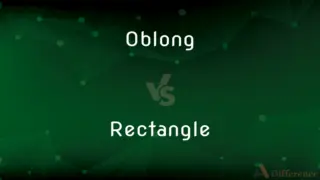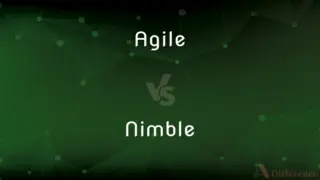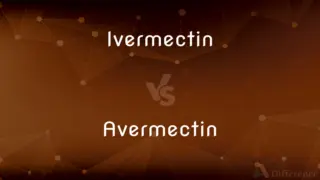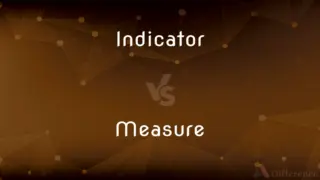Stem vs. Branch — What's the Difference?
By Tayyaba Rehman & Fiza Rafique — Updated on March 8, 2024
Stem is the main support of a plant, transporting nutrients and water, while branches are subdivisions, growing from the stem to bear leaves, flowers, or fruit.
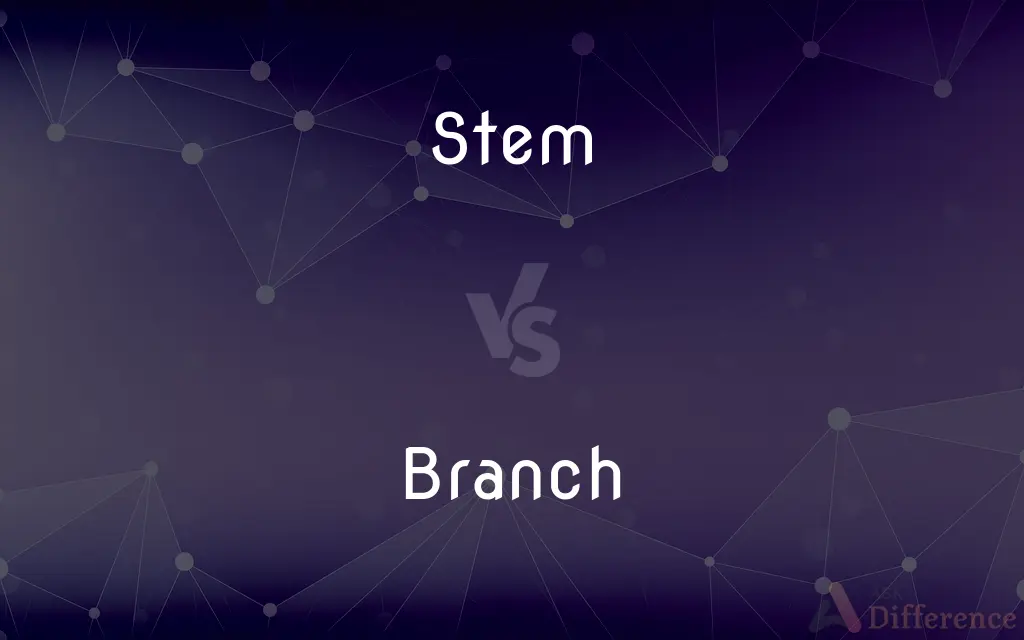
Difference Between Stem and Branch
Table of Contents
ADVERTISEMENT
Key Differences
The stem of a plant plays a crucial role as the main support system, responsible for transporting water and nutrients from the roots to different parts of the plant, including branches. Whereas branches are secondary offshoots that grow from the main stem, serving primarily to spread out leaves for photosynthesis and sometimes bear flowers and fruits.
Stems are generally characterized by their growth directly upwards from the ground or from the main root, providing the primary axis of the plant body. On the other hand, branches typically grow outwards from the stem, expanding the plant's reach and exposure to sunlight, which is vital for photosynthesis.
In terms of function, the stem also houses the vascular system of a plant, including the xylem and phloem, crucial for nutrient transport. Branches, while they contain these vascular tissues, primarily function to increase the plant’s surface area for sunlight absorption and gas exchange through the leaves.
From a developmental perspective, stems originate from the plant's embryonic stages, forming the central structure of the plant. Branches develop later as the plant grows, emerging from the stem's nodes, where the leaf attaches to the stem.
Stem modifications can include structures like rhizomes, tubers, and corms, which serve various functions including storage and vegetative reproduction. Branches can also undergo modifications, such as transforming into thorns or cladodes, adaptations that can aid in protection and water storage.
ADVERTISEMENT
Comparison Chart
Main Function
Support, nutrient and water transport
Spread out leaves, bear flowers/fruits
Growth Origin
From the ground or main root
From the stem’s nodes
Growth Direction
Upwards
Outwards
Contains
Vascular system (xylem and phloem)
Also contains vascular tissues
Modifications
Rhizomes, tubers, corms
Thorns, cladodes
Compare with Definitions
Stem
Can undergo modifications like tubers for storage.
Potato plants store nutrients in the stem modifications known as tubers.
Branch
Secondary offshoot of the stem, bearing leaves or fruits.
Apple trees produce fruit on their branches.
Stem
Supports the plant and transports nutrients and water.
The stem of a sunflower can grow over 3 meters tall.
Branch
Emerges from the stem's nodes.
New branches sprout from the nodes where leaves attach to the stem.
Stem
Carries the vascular system of the plant.
The stem's vascular tissue transports water from the roots to the leaves.
Branch
Grows outwards from the stem to spread leaves.
The oak tree's branches spread wide to maximize sunlight absorption.
Stem
Originates from the plant's embryonic stages.
The stem begins to develop as soon as a seed starts to germinate.
Branch
Can develop into specialized forms like thorns.
Rose branches are modified into thorns for protection.
Stem
Grows directly upwards from the ground.
The bamboo stem can grow straight up to reach sunlight efficiently.
Branch
Increases plant's surface area for photosynthesis.
The broad branches of a maple tree increase its photosynthetic capability.
Stem
The main ascending part of a plant; a stalk or trunk.
Branch
A branch (UK: or UK: , US: ) or tree branch (sometimes referred to in botany as a ramus) is a woody structural member connected to but not part of the central trunk of a tree (or sometimes a shrub). Large branches are known as boughs and small branches are known as twigs.
Stem
A slender stalk supporting or connecting another plant part, such as a leaf or flower.
Branch
A part of a tree which grows out from the trunk or from a bough
Sophie was in the branches of a tree eating an apple
Stem
A banana stalk bearing several bunches of bananas.
Branch
(of a road or path) divide into one or more subdivisions
Follow this track south until it branches into two
Stem
The tube of a tobacco pipe.
Branch
(of a tree or plant) bear or send out branches
This rose has a tendency to branch and spread at the top
The branching heads of large yellow daisies
Stem
The slender upright support of a wineglass or goblet.
Branch
A secondary woody stem or limb growing from the trunk or main stem of a tree or shrub or from another secondary limb.
Stem
The small projecting shaft with an expanded crown by which a watch is wound.
Branch
A lateral division or subdivision of certain other plant parts, such as a root or flower cluster.
Stem
The rounded rod in the center of certain locks about which the key fits and is turned.
Branch
A secondary outgrowth or subdivision of a main axis, such as the tine of a deer's antlers.
Stem
The shaft of a feather or hair.
Branch
An area of specialized skill or knowledge, especially academic or vocational, that is related to but separate from other areas
The judicial branch of government.
The branch of medicine called neurology.
Stem
The upright stroke of a typeface or letter.
Branch
A division of a business or other organization.
Stem
(Music) The vertical line extending from the head of a note.
Branch
A division of a family, categorized by descent from a particular ancestor.
Stem
The main line of descent of a family.
Branch
(Linguistics) A subdivision of a family of languages, such as the Germanic branch of Indo-European.
Stem
(Linguistics) The main part of a word to which affixes are added.
Branch
A tributary of a river.
Stem
(Nautical) The curved upright beam at the fore of a vessel into which the hull timbers are scarfed to form the prow.
Branch
Chiefly Southern US See creek. See Note at run.
Stem
The tubular glass structure mounting the filament or electrodes in an incandescent bulb or vacuum tube.
Branch
A divergent section of a river, especially near the mouth.
Stem
To have or take origin or descent
Her success stems mostly from hard work.
Branch
(Mathematics) A part of a curve that is separated, as by discontinuities or extreme points.
Stem
To remove the stem of
Stemmed the apples.
Branch
A sequence of program instructions to which the normal sequence of instructions relinquishes control, depending on the value of certain variables.
Stem
To provide with a stem
Wine glasses that are stemmed.
Branch
The instructions executed as the result of such a passing of control.
Stem
To make headway against (a tide or current, for example).
Branch
(Chemistry) A bifurcation in a linear chain of atoms, especially in an organic molecule where isomeric hydrocarbon groups can vary in the location and number of these bifurcations of the carbon chain.
Stem
To stop or stanch (a flow)
Stemmed the bleeding.
Branch
To put forth a branch or branches; spread by dividing.
Stem
To restrain or stop
Wanted to stem the growth of government.
Branch
To come forth as a branch or subdivision; develop or diverge from
An unpaved road that branches from the main road.
A theory that branches from an older system of ideas.
Stem
To plug or tamp (a blast hole, for example).
Branch
(Computers) To relinquish control to another set of instructions or another routine as a result of the presence of a branch.
Stem
(Sports) To turn (a ski, usually the uphill ski) by moving the heel outward.
Branch
To separate (something) into branches.
Stem
To stem a ski or both skis, as in making a turn.
Branch
To embroider (something) with a design of foliage or flowers.
Stem
The stock of a family; a race or generation of progenitors.
Branch
The woody part of a tree arising from the trunk and usually dividing.
Stem
A branch of a family.
Branch
Any of the parts of something that divides like the branch of a tree.
The branch of an antler, a chandelier, or a railway
Stem
An advanced or leading position; the lookout.
Branch
A creek or stream which flows into a larger river.
Branch water
Stem
(botany) The above-ground stalk (technically axis) of a vascular plant, and certain anatomically similar, below-ground organs such as rhizomes, bulbs, tubers, and corms.
Branch
(geometry) One of the portions of a curve that extends outwards to an indefinitely great distance.
The branches of a hyperbola
Stem
A slender supporting member of an individual part of a plant such as a flower or a leaf; also, by analogy, the shaft of a feather.
The stem of an apple or a cherry
Branch
A location of an organization with several locations.
Our main branch is downtown, and we have branches in all major suburbs.
Stem
A narrow part on certain man-made objects, such as a wine glass, a tobacco pipe, a spoon.
Branch
A line of family descent, in distinction from some other line or lines from the same stock; any descendant in such a line.
The English branch of a family
Stem
(linguistics) The main part of an uninflected word to which affixes may be added to form inflections of the word. A stem often has a more fundamental root. Systematic conjugations and declensions derive from their stems.
Branch
(Mormonism) A local congregation of the LDS Church that is not large enough to form a ward; see Wikipedia article on ward in LDS church.
Stem
(typography) A vertical stroke of a letter.
Branch
An area in business or of knowledge, research.
Stem
(music) A vertical stroke marking the length of a note in written music.
Branch
(nautical) A certificate given by Trinity House to a pilot qualified to take navigational control of a ship in British waters.
Stem
(music) A premixed portion of a track for use in audio mastering and remixing.
Branch
(computing) A sequence of code that is conditionally executed.
Stem
(nautical) The vertical or nearly vertical forward extension of the keel, to which the forward ends of the planks or strakes are attached.
Branch
(computing) A group of related files in a source control system, including for example source code, build scripts, and media such as images.
Stem
(cycling) A component on a bicycle that connects the handlebars to the bicycle fork.
Branch
(rail transport) A branch line.
Stem
(anatomy) A part of an anatomic structure considered without its possible branches or ramifications.
Branch
(intransitive) To arise from the trunk or a larger branch of a tree.
Stem
(slang) A crack pipe; or the long, hollow portion of a similar pipe (i.e. meth pipe) resembling a crack pipe.
Branch
(intransitive) To produce branches.
Stem
A winder on a clock, watch, or similar mechanism.
Branch
(ambitransitive) To (cause to) divide into separate parts or subdivisions.
Stem
Alternative form of STEM
Branch
To jump to a different location in a program, especially as the result of a conditional statement.
Stem
A lesbian, chiefly African-American, exhibiting both stud and femme traits.
Branch
(transitive) To strip of branches.
Stem
To remove the stem from.
To stem cherries; to stem tobacco leaves
Branch
To discipline (a union member) at a branch meeting.
Stem
To be caused or derived; to originate.
The current crisis stems from the short-sighted politics of the previous government.
Branch
A shoot or secondary stem growing from the main stem, or from a principal limb or bough of a tree or other plant.
Stem
To descend in a family line.
Branch
Any division extending like a branch; any arm or part connected with the main body of thing; ramification; as, the branch of an antler; the branch of a chandelier; a branch of a river; a branch of a railway.
Most of the branches , or streams, were dried up.
Stem
To direct the stem (of a ship) against; to make headway against.
Branch
Any member or part of a body or system; a distinct article; a section or subdivision; a department.
It is a branch and parcel of mine oath.
Stem
(obsolete) To hit with the stem of a ship; to ram.
Branch
One of the portions of a curve that extends outwards to an indefinitely great distance; as, the branches of an hyperbola.
Stem
To ram (clay, etc.) into a blasting hole.
Branch
A line of family descent, in distinction from some other line or lines from the same stock; any descendant in such a line; as, the English branch of a family.
His father, a younger branch of the ancient stock.
Stem
(skiing) To move the feet apart and point the tips of the skis inward in order to slow down the speed or to facilitate a turn.
Branch
A warrant or commission given to a pilot, authorizing him to pilot vessels in certain waters.
Stem
To gleam.
His head bald, that shone as any glass, . . . [And] stemed as a furnace of a leed [caldron].
Branch
Diverging from, or tributary to, a main stock, line, way, theme, etc.; as, a branch vein; a branch road or line; a branch topic; a branch store.
Stem
To remove the stem or stems from; as, to stem cherries; to remove the stem and its appendages (ribs and veins) from; as, to stem tobacco leaves.
Branch
To shoot or spread in branches; to separate into branches; to ramify.
Stem
To ram, as clay, into a blasting hole.
Branch
To divide into separate parts or subdivision.
To branch out into a long disputation.
Stem
To move forward against an obstacle, as a vessel against a current.
Stemming nightly toward the pole.
Branch
To divide as into branches; to make subordinate division in.
Stem
A gleam of light; flame.
Branch
To adorn with needlework representing branches, flowers, or twigs.
The train whereof loose far behind her strayed,Branched with gold and pearl, most richly wrought.
Stem
The principal body of a tree, shrub, or plant, of any kind; the main stock; the part which supports the branches or the head or top.
After they are shot up thirty feet in length, they spread a very large top, having no bough nor twig in the trunk or the stem.
The lowering spring, with lavish rain,Beats down the slender stem and breaded grain.
Branch
An administrative division of some larger or more complex organization;
A branch of Congress
Stem
A little branch which connects a fruit, flower, or leaf with a main branch; a peduncle, pedicel, or petiole; as, the stem of an apple or a cherry.
Branch
A division of a stem, or secondary stem arising from the main stem of a plant
Stem
The stock of a family; a race or generation of progenitors.
While I do pray, learn here thy stemAnd true descent.
Branch
A part of a forked or branching shape;
He broke off one of the branches
They took the south fork
Stem
A branch of a family.
This is a stemOf that victorious stock.
Branch
A natural consequence of development
Stem
A curved piece of timber to which the two sides of a ship are united at the fore end. The lower end of it is scarfed to the keel, and the bowsprit rests upon its upper end. Hence, the forward part of a vessel; the bow.
Branch
A stream or river connected to a larger one
Stem
Fig.: An advanced or leading position; the lookout.
Wolsey sat at the stem more than twenty years.
Branch
Any projection that is thought to resemble an arm;
The arm of the record player
An arm of the sea
A branch of the sewer
Stem
Anything resembling a stem or stalk; as, the stem of a tobacco pipe; the stem of a watch case, or that part to which the ring, by which it is suspended, is attached.
Branch
Grow and send out branches or branch-like structures;
These plants ramify early and get to be very large
Stem
That part of a plant which bears leaves, or rudiments of leaves, whether rising above ground or wholly subterranean.
Branch
Divide into two or more branches so as to form a fork;
The road forks
Stem
The entire central axis of a feather.
Stem
The short perpendicular line added to the body of a note; the tail of a crotchet, quaver, semiquaver, etc.
Stem
The part of an inflected word which remains unchanged (except by euphonic variations) throughout a given inflection; theme; base.
Stem
(linguistics) the form of a word after all affixes are removed;
Thematic vowels are part of the stem
Stem
A slender or elongated structure that supports a plant or fungus or a plant part or plant organ
Stem
Cylinder forming a long narrow part of something
Stem
The tube of a tobacco pipe
Stem
Front part of a vessel or aircraft;
He pointed the bow of the boat toward the finish line
Stem
A turn made in skiing; the back of one ski is forced outward and the other ski is brought parallel to it
Stem
Grow out of, have roots in, originate in;
The increase in the national debt stems from the last war
Stem
Cause to point inward;
Stem your skis
Stem
Remove the stem from;
For automatic natural language processing, the words must be stemmed
Common Curiosities
How do branches contribute to a plant's growth?
Branches spread out leaves for photosynthesis and can bear flowers and fruits, contributing to the plant's reproduction and growth.
What is the main difference between stem and branch growth?
Stems grow upwards, forming the plant’s main axis, while branches grow outwards from the stem to increase the plant's exposure to sunlight.
Why are the vascular tissues important in stems?
Vascular tissues in stems, including xylem and phloem, are crucial for transporting water, nutrients, and food throughout the plant.
How do branches affect a plant's ability to photosynthesize?
Branches increase the plant’s surface area for sunlight absorption, enhancing its photosynthetic efficiency.
How do environmental factors affect stem and branch growth?
Environmental factors like light, water availability, and nutrient supply can influence the growth patterns, size, and health of stems and branches.
Where do stems originate from?
Stems originate from the ground or the main root of the plant, growing directly upwards.
Can stems and branches undergo modifications?
Yes, both can undergo modifications, such as stems becoming tubers for nutrient storage and branches developing into thorns for protection.
Can branches grow directly from the ground?
No, branches grow from the stem's nodes, not directly from the ground.
What is the primary function of a stem?
The stem supports the plant and transports nutrients and water throughout the plant.
What role do branches play in a plant's reproductive process?
Branches can bear flowers and fruits, playing a direct role in the plant's reproductive cycle.
Are there any specific conditions that favor branch development over stem growth?
Yes, conditions that favor maximum sunlight exposure and efficient photosynthesis can lead to more extensive branch development.
What are stem modifications?
Stem modifications include structures like rhizomes, tubers, and corms, which serve functions such as storage and vegetative reproduction.
Do all plants have distinguishable stems and branches?
Most plants have distinguishable stems and branches, but some plants may have structures that function similarly without clear distinction.
What is the significance of nodes in branch development?
Nodes are crucial for branch development as they are the points on the stem where branches, as well as leaves, originate.
How does the growth direction of stems and branches differ?
Stems grow upwards, while branches grow outwards, enabling the plant to cover more space and access more sunlight.
Share Your Discovery

Previous Comparison
Rectangular vs. Rectangle
Next Comparison
Gossip vs. WhisperingAuthor Spotlight
Written by
Tayyaba RehmanTayyaba Rehman is a distinguished writer, currently serving as a primary contributor to askdifference.com. As a researcher in semantics and etymology, Tayyaba's passion for the complexity of languages and their distinctions has found a perfect home on the platform. Tayyaba delves into the intricacies of language, distinguishing between commonly confused words and phrases, thereby providing clarity for readers worldwide.
Co-written by
Fiza RafiqueFiza Rafique is a skilled content writer at AskDifference.com, where she meticulously refines and enhances written pieces. Drawing from her vast editorial expertise, Fiza ensures clarity, accuracy, and precision in every article. Passionate about language, she continually seeks to elevate the quality of content for readers worldwide.






